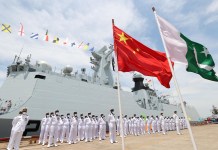On Saturday, the festival of Diwali was widely celebrated in India and many other parts of the world. While the controversies over the use of firecrackers and pollution remained the highlight over social media, a contrasting battle raged on at the Line of Actual Control which led to the deaths of many lives of the Indian and Pakistani side.
The bunker-busting videos by the Indian Army along the LOC emerged on social media, but it was the Indian Navy which drew a lot of attention.
In the morning hours of the day, the Indian Navy released a video named “Fireworks at Sea”, flaunting the service’s way of celebrating Diwali with the customary firecrackers.
Fireworks at Sea – the #IndianNavy Way pic.twitter.com/bd3rXxwKj1
— SpokespersonNavy (@indiannavy) November 14, 2020
The video showcased the firing of various weapons platforms, including naval guns, anti-submarine rockets, torpedoes, surface-to-surface missiles, and the service’s venerable MiG-29Ks- along with precise cinematic shots of various warships.
The most notable systems shown firing were the BrahMos supersonic surface to surface missile, and its Russian subsonic counterpart the Kh-35 ‘Uran’. The RBU-6000 anti-submarine rockets also added to the fire-display.
The BrahMos
This name would be familiar to most people having an interest in the defense and security sector. Being dubbed as the most capable in-service supersonic cruise missile, this system has been the main focus of development in the missile sphere with the DRDO.
It was developed as a joint venture between India and Russia and takes its name from two of the most famous rivers in the respective countries- Brahmaputra (India) and Moskva (Russia).
The missile has a range of 300 kilometers initially, with the extended range variants being tested with India’s entry into the Missile Technology Control Regime (MTCR).

On 30th September, the country tested an extended range version of BrahMos, allegedly with a range of 400 kilometers. The latest test was conducted from a stealth Kolkata-Class destroyer INS Chennai on 18th October.
It provides the Indian Navy an unprecedented lethality to maintain its dominance in the Indian Ocean and at its deployments worldwide, including the South China Sea. It is also being reported that the missile shall be exported to the Philippines soon.
Kh-35 ‘Uran’
It is said to be the Russian answer to the American Harpoon missile, and can credibly take down a 5,000-tonne warship with a single hit. It can be launched from either aerial platforms or surface vessels.
Having a 145 kg high explosive fragmentation shaped charge warhead, the missile travels with a subsonic speed of roughly 0.8-0.9 Mach, and its aerodynamic configuration is optimized for high subsonic-speed sea-skimming flight to ensure stealthy characteristics of the missile – reaching just 4m altitude during its terminal phase.
It has an operational range of about 130-300 kilometers depending upon the variant. It is currently in service with the navies of 10 countries globally.
RBU-6000 ‘Smerch-2’
This is one of the lesser-known additions to the Indian Navy ships, and are clearly identifiable from a range giving a signal to enemy submarines to stay away. The system is an Anti-Submarine Rocket Launcher having the capability of being used even against incoming torpedoes and divers.
It consists of a horseshoe-shaped arrangement of twelve launch barrels, that are remotely directed by a fire control system. It fires RGB-60 unguided depth charges. The rockets are normally fired in salvos of 1, 2, 4, 8 or 12 rounds. Reloading is automatic, with individual rounds being fed into the launcher by the 60UP loading system from a below-deck magazine.
The typical magazine capacity is either 72 or 96 rounds per launcher. It can also be used as a shore bombardment system.
The newer guided rockets are used with an upgrade, enabling the system to kill enemy underwater systems to depths of 1,000 meters with incredible accuracy. System response time is reported to be 15 seconds and a single-salvo has a kill probability of 0.8 and is one of the best defensive systems in service.
It is installed on virtually every frontline combat ship of the Indian Navy and will be installed on the upcoming vessels as well.




